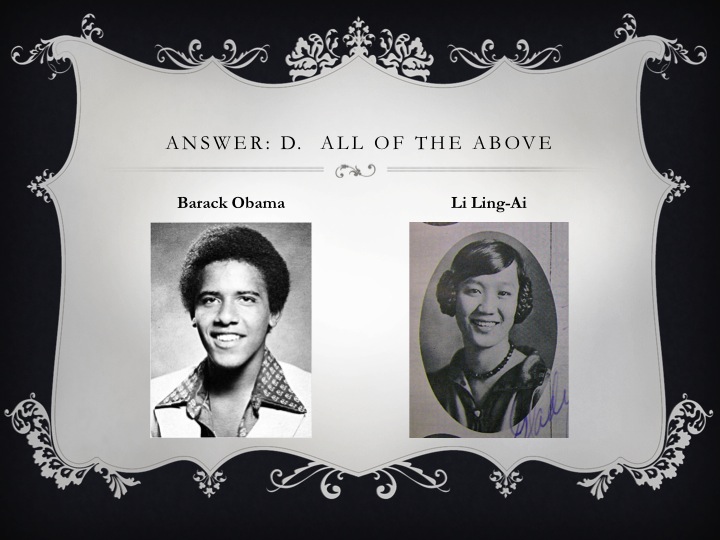Upcoming Screenings:
no event
Follow us on Facebook
HELP BRING FINDING KUKAN TO CLASSROOMS
Sign up for our mailing list.
Category Archives: Research
The Power of the Press, Part 2 — Roy Cummings
A blog in support of FINDING KUKAN’s 10K in 10weeks “Keep This Film Alive Campaign”.
How was the pioneering female reporter May Day Lo connected to KUKAN’s co-producer Li Ling-Ai? Leads to that question had dried up for me a long time ago. Then last November Honolulu Star-Advertiser reporter Mike Gordon wrote a big feature article about FINDING KUKAN. I received a number of enthusiastic emails about the article and one strange phone call.
“I’m so mad!” Those were the first words Susan Cummings said to me. “I’m sure he knew her. If only he were still here, he could tell you.” She was referring to her husband who was no longer alive. To tell you the truth, I thought Susan might be a raving lunatic. But as we talked longer I realized that Susan’s late husband was Roy Cummings. He’d been a reporter at the Honolulu Advertiser in 1937, the same year KUKAN’s director Rey Scott started working there. Like Rey Scott, he had roots in Missouri. Roy was also notable for trying to unionize the Advertiser at that time. Susan told me he was fired for doing so, was almost run over in a parking lot, and blackballed by the Honolulu Star-Bulletin too. It would take Roy Cummings another 12 years to establish the Hawaii Newspaper Guild in 1949. He seemed just like the kind of guy that Rey Scott would gravitate to.

Roy Cummings founded the Hawaii Newspaper Guild in 1949 (photo courtesy of Honolulu Star-Bulletin)
Coincidentally Roy’s first wife Margaret Kam had been a “person of interest” to me when I was trying to hunt down the real life inspirations for the detective Lily Wu. Because Margaret was a colorful character too – a Chinese actress and reporter in Hawaii who had the gumption to marry a white guy at a time when traditional Chinese families still frowned upon those things.

Margaret Kam (center) mans the all female copy desk at the Honolulu Star-Bulletin during WWII (courtesy Susan Cummings)
Once I made the connection, the conversation with Susan started sparking with names and situations from Roy Cummings’s past. I mentioned that I had been trying to find information on the Star Bulletin reporter May Day Lo, and Susan exclaimed, “May Day Lo was Roy’s first love!” It turns out that Roy and May Day went to journalism school together in Missouri. Roy fell in love with May Day and followed her out to Hawaii.

May Day Lo and Roy Cummings (center) gather with fellow University of Missouri journalism students in downtown Columbia
Now I was the one who was mad that Roy was no longer alive. I felt sure that he’d been acquainted with Li Ling-Ai and Rey Scott in one way or another. He probably could have provided some interesting stories about the two of them and the making of KUKAN. Susan graciously invited me over to her house in Lanikai to look at Roy’s photograph from the time period – the next best thing to meeting the man in person.
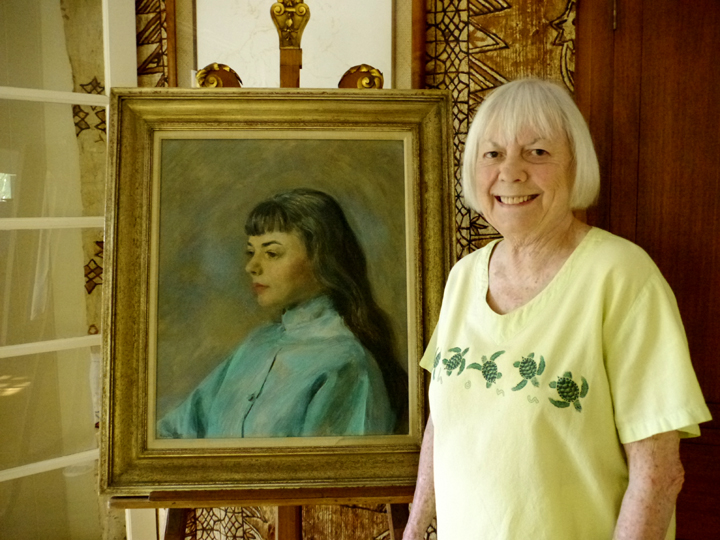
Susan Cummings with Wyeth portrait
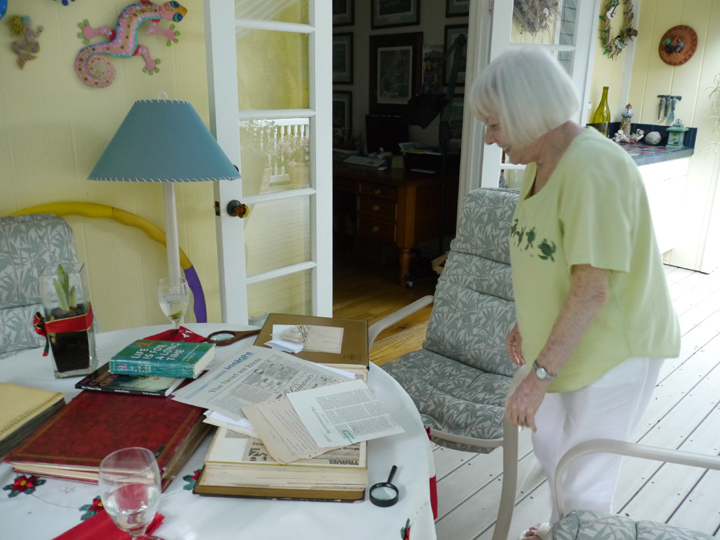
Susan Cummings hunts for clues in her husband’s photo albums
Roy’s photos put more flesh and blood on what had previously been merely names on a page. They also gave me some insight into the lifestyle Rey Scott must have experienced when he first arrived here.

Aloha Tower in the mid 1930s (photo courtesy Susan Cummings)

Like Roy Cummings, Rey Scott holed up in Waikiki when he first got to Hawaii. Could his room have looked like this? (photo courtesy of Susan Cummings)
But the photos didn’t do much to fill in the gaps of the KUKAN story. In fact they brought up more questions than answers. Susan herself was mystified as to what happened between May Day Lo and Roy. Why had he married Margaret Kam instead of May Day? She’d never thought to ask Roy about it when he was alive. I wanted to know if anyone had saved May Day’s papers and if Ling-Ai’s letters or clues to KUKAN were amongst them.
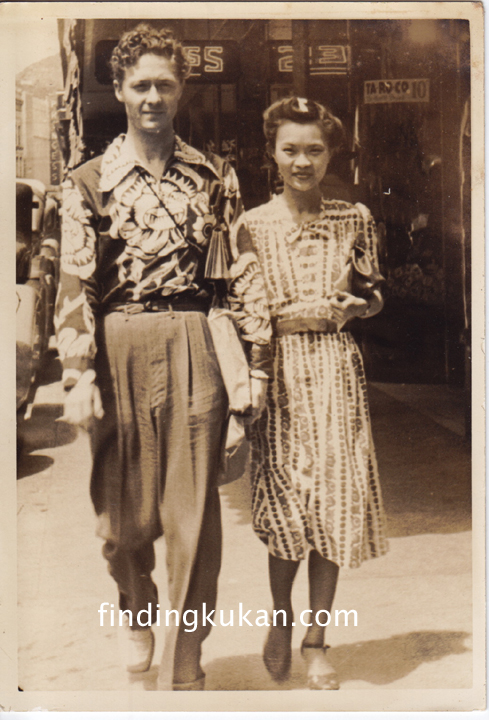
Roy Cummings and May Day Lo in downtown Honolulu (photo courtesy Susan Cummings)
Egged on by mutual curiosity Susan and I exchanged a flurry of emails and research findings in the next few weeks. Susan proved to be a willing and able sleuth, and together we found out some very interesting things which I’ll share in future posts. For now I want to pay tribute to the “father of the Hawaii Newspaper Guild” and thank the ghost of Roy Cummings for putting Susan and I together. Of course the “power of the press” had a lot to do with it too.
Support our 10K in 10 Weeks campaign by clicking the red button. 
(As of 9/24/13 we have raised $7,165 and have $2,835 more to raise by 10/15/13)
The Power of the Press: Part 1– May Day Lo
A blog in support of FINDING KUKAN’s 10K in 10weeks “Keep This Film Alive Campaign”.
In the Lily Wu detective novels by Juanita Sheridan one of the colorful sidekicks is a female reporter named Steve (Stephanie Dugan) who funnels information to her two amateur detective friends Lily and Janice. Since many of her fictional characters are based on real life people, I wondered if Sheridan based Steve on some of the ballsy female reporters who were breaking into newsrooms in the 1930s. So my ears pricked when I heard that Li Ling-Ai had a journalist friend in the 30s and 40s named May Day Lo. Yes, that is her real name, and no she was not even born in May.

May Day Lo at the University of Missouri (photo courtesy Susan Cummings)
In the mid 1930s May Day Lo made history by being one of the first Asian American women hired to report for a major daily newspaper. The progressive Honolulu Star-Bulletin hired Lo and Ah Jook Ku after they graduated from the University of Missouri Journalism School. May Day Lo also broke ground at Journalism School by being the first “exchange student” accepted there (remember, Hawaii was still a territory and not officially part of the United States).
Notably, in 2010 when the Asian American Journalists Association put together a list of pioneering Asian journalists, a majority of them were from Hawaii. AAJA historian Chris Chow commented, “Hawaii was more open to multiculturalism. There was recognition that this is an important market and you’d better well serve them (Asian-Americans) if you want to make any money.”
Back in the 30’s, the Star Bulletin seemed to cover stories about local Asians more comprehensively than the rival Honolulu Advertiser. And May Day Lo’s byline was on several early articles written about Li Ling-Ai, including the one that probably prompted Advertiser reporter Rey Scott to call Li Ling-Ai into his office for an interview on that fateful night in 1937 when plans for making KUKAN were first hatched.

Reporter May Day Lo gives front page coverage to fellow Chinese American pioneer — Li Ling-Ai (aka Gladys Li)
I love knowing that a petite Chinese woman who was raised by a reverend in Hilo was the first exchange student at the prestigious University of Missouri School of Journalism and that the power of her pen brought attention to another pioneering Chinese young woman in a way that changed her life forever. I wanted to find out more about May Day Lo, especially when I found an intriguing letter from her to Li Ling-Ai:
July 31, 1941,
Dear Li Ling Ai,
Now that I am home again, it all seems like a dream that I met you and all the others in New York and had such a wonderful time…. Please give my Aloha to Mrs. James Young, Rey Scott and Mr. Ripley when you see them.
May Day Lo had been in New York right around the time when KUKAN premiered at the World Theater just off Broadway! She had met both Rey Scott and Robert Ripley – two key players in Li Ling-Ai’s life at the time. Could May Day hold clues to some of the unsolved mysteries surrounding KUKAN?
Unfortunately May Day had died in a tragic car accident in 1986. May Lee Chung, editor of the ACUW publication that documents so many pioneering Chinese women’s lives (see other posts about this “Orange Bible”), could remember clearly the circumstances of May Day’s death. But she did not know what had become of May Day’s only child David, someone who might be able to tell me more. The trail remained cold until the Power of the Press struck again in 2011. Stay tuned…
Support our 10K in 10 Weeks campaign by clicking the red button. 
(As of 9/6/13 we have raised $5,025 and have $4,975 more to raise by 10/15/13)
Soo Yong – Another Chinese Woman We Should Know More About – Part 2
A blog in support of FINDING KUKAN’s 10K in 10weeks “Keep This Film Alive Campaign”.
A family story often told about Soo Yong (born Ahee Young) is that when she was four or five years old her father became gravely ill and summoned the family to hear his last words. But Ahee was missing. The family searched all over for her. They finally found her in Wailuku town. She was completely mesmerized by the performance of a Chinese opera troupe who had come to town. This is Soo Yong’s earliest dramatic memory.

Chinese Opera Performers in Hawaii
Si it must have been a dream come true for Soo Yong when in 1930, at 28 years of age, she was chosen to accompany the most famous Chinese opera star of all time on a six-month tour of America.
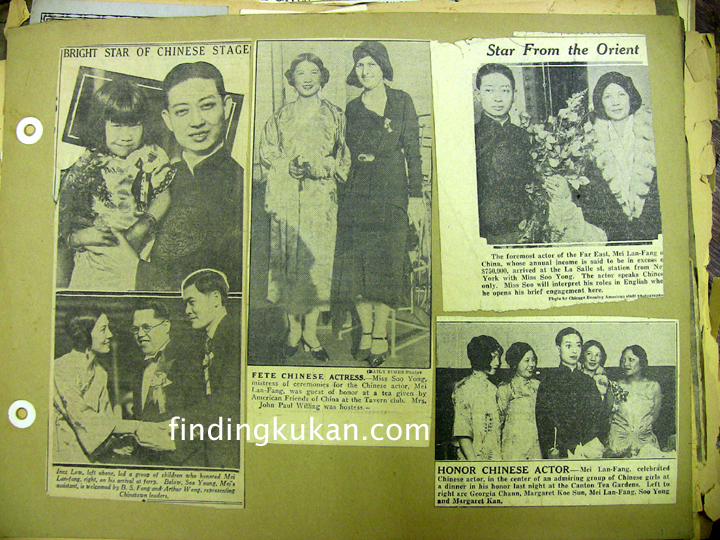
Soo Yong acts as Mistress of Ceremonies for Mei Lanfang’s 1930 tour of America
Mei Lanfang was also idolized by Li Ling-Ai whose dramatic interests were stirred up by Chinese opera performances her father took her to when she was a young girl. During his 1930 tour Mei stopped in Honolulu and Li Ling-Ai had a chance to meet him.

Photo from the ACUW publication TRADITIONS FOR LIVING
A year or so later Li Ling-Ai left on her second trip to China and told newspaper reporters she intended to study with the great man – a lofty goal for a recent graduate of the University of Hawaii. I wondered if Soo Yong’s insider position emboldened Li Ling-Ai to approach the great Mei for lessons.

Honolulu Star Bulletin Article from August 6, 1932
I found no subsequent mention of Li Ling-Ai studying with Mei Lanfang. But several biographies of Li state that she studied privately with the famous dancer Chu Kuei Fang. It was hard to find any mention of Chu Kuei Fang on the internet and I began to doubt Li Ling-Ai’s claims. But in Soo Yong’s personal scrapbook that was donated to the University of Hawaii, I discovered Chu listed as a performer in a 1930 program for Mei Lanfang’s tour.
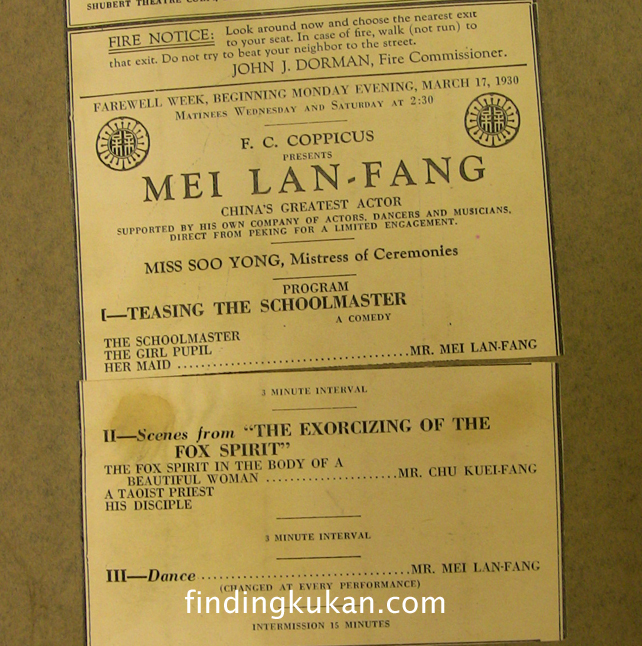
Chu Kue-Fang performs on the same program as Mei Lanfang
Chu must have been very accomplished to share stage time with the great Mei Lanfang. I wonder if this old photo, found amongst Li Ling-Ai’s possessions, is of Chu Kuei Fang. If anyone can positively identify the man in the photo, please let me know.

Could the man behind Li Ling-Ai be Chu Kuei-Fang?
Soo Yong and Li Ling-Ai also shared a passion for helping their Chinese homeland during the Japanese invasion of the country. As early as 1937 Soo Yong was performing in benefits to aid Chinese refugees.

December 1937 Soo Yong hosts tea for China Relief
1937 was also the year that Li Ling-Ai sent Rey Scott to China so that the story of the people of China could be told in photographs and film – the film would eventually become KUKAN. Whether Soo Yong was a role model for Li Ling-Ai or simply another extraordinary Chinese woman who became a political activist when war came we might never know. But one thing’s for certain — we should definitely know more about her than we do.
Soo Yong: Another Chinese Woman We Should Know More About — Part I

Could the Chinese American actress Soo Yong have been an inspiration for the fictional Lily Wu? (photo courtesy of Barbara Wong)
I’m starting a 10-week blog-a-thon in support of our 10K in 10weeks “Keep This Film Alive Campaign”. The goal: get us back into the edit room on October 15 to finish a rough cut of FINDING KUKAN. What better way to kick off that effort than to re-visit my search for LILY WU – the fictional detective created by author Juanita Sheridan. According to Lily’s friend and Watson-like companion Janice Cameron, “Lily is a chameleon. She can change effortlessly into whatever character the occasion requires…” Lily is also smarter, sexier and more worldly than most of the Caucasian characters she runs into.

This book, published by the Associated Chinese University Women of Hawaii, is a wonderful collection of short bios
While trying to locate the real life inspirations for Lily Wu I recall poring over what I now think of as THE ORANGE BIBLE (see photo above) and stopping short at the entry for Soo Yong. Why? Because Soo Yong was a Chinese movie star from Hawaii! She appeared glamorous and gutsy, running away from a restrictive small town life in Wailuku, Maui for the more cosmopolitan Honolulu where she put herself through school at the University of Hawaii and then Columbia University in NYC. She was just the kind of woman who might have inspired Juanita Sheridan to create Lily Wu. But my interest in Soo Yong tailed off when I discovered that Soo Yong had left Hawaii before Juanita Sheridan arrived there, making it unlikely that the two women were friends.
My interest in Soo Yong was re-ignited when Li Ling-Ai’s sole surviving sister mentioned that Ling-Ai had spent time in Hollywood and had been friendly with a Chinese actress from Maui. Sure enough, a keyword search through the Los Angeles Times brought up a 1936 article placing Soo Yong and Li Ling-Ai together in Hollywood:
“East is east and west is west, and the two of them met last Tuesday afternoon at Joine Alderman’s Salon. The east was personified by a lovely Chinese lady whose name and voice are poetry itself, Li Ling Ai. Clad in her native black satin robes, embroidered in gold and silver and shining colors, she told the forty or so debs who comprise the salon about her native country. … And her words about the beauties of Pekin and her studies in ancient philosophy were translated to the debs by another Chinese-robed lady, Soo Yung.”
The gossip column inaccurately assumed that Ling-Ai could not speak English and Soo Yong was there merely as a translator, but it whetted my appetite to learn more about Soo Yong. Could she have been a mentor or role model for Li Ling-Ai?

Clark Gable and Soo Yong in The China Seas
Being an old movie nut, one of the first things I did was rent one of the Clark Gable movies Soo Yong had been in, China Seas. Although the movie depicts most Chinese in stereotypical coolie roles, Soo Yong convincingly plays a high-brow Chinese aristocrat who out-classes Gable’s ex-girlfriend played by Jean Harlow. This small 1935 role would lead to Yong playing two parts in the 1937 hit The Good Earth. She was also Jack Soo’s mother in Flower Drum Song and had supporting roles in Soldier of Fortune with Clark Gable, Peking Express with Joseph Cotton, and Love is a Many Splendored Thing with Jennifer Jones. Why we don’t know much about her may be because she was never able to have a full-fledged Hollywood movie career.

In 1935 Soo Yong advised islanders that Asians have “A Chinaman’s Chance” of breaking into Hollywood.
In the 1930s Soo Yong was interviewed by Loui Leong Hop for the Honolulu Star-Bulletin:
“When asked about the possibility for local-born orientals to break into the talkies, she simply said, “A Chinese has a Chinaman’s Chance.” Explaining further on this point Miss Young stated that at present the Hollywood studios are name crazed. If there’s a production which required an oriental to play the part, the Hollywood producers would invariably select one of their more famous actors or actresses.”
Unfortunately not much has changed in Hollywood, and Asians still struggle to find starring roles on the big screen.

Soo Yong, Interpreter of China to America
Soo Yong would eventually make a living on the lecture circuit, performing entertaining Chinese monologues to educate audiences around the country about Chinese culture. As of this date Soo Yong does not even have a Wikipedia page, but we should definitely know more about this pioneering Chinese American actress. Stay tuned for part two of this blog where I’ll write about some amazing discoveries I found in Soo Yong’s personal scrapbook.
Support our 10K in 10 Weeks campaign by clicking the red button. 
April 25, 2013 — Major Archival Discovery Starts with a Party
It was my husband Paul who convinced me that I should have a fundraising party. So last October I got many volunteers together to throw one. Terry Lehman Olival helped by sending press releases to the local media and got the attention of Star-Advertiser reporter Mike Gordon.

Mellanie Lee, Debra Zeleznick, Robin Lung and Terry Olival at “A Night in Old Shanghai” fundraiser
“That might be the coolest story I’ve heard in a long time,” Mike said, and promised to write an article on it. The more Mike found out, the more he wanted to know. His article grew and grew. My fundraising party came and went; my Kickstarter campaign came and went.
Finally the opus turned up – a 3‑page spread on the film, complete with color pictures, showed up in the Sunday newspaper and drew response from people as far away as Kentucky!

Mike Gordon’s article “Reel Obsession” appears in the November 18, 2012 Honolulu Star-Advertiser
DeSoto Brown, curator at the Bishop Museum, also read Mike’s article and something clicked. He remembered a donation of lantern slides made to the museum by Betty Li, Li Ling-Ai’s older physician sister, back in the 80’s. In fact the slides were marked as being related to KUKAN! Early in my research I had read that KUKAN’s director Rey Scott lectured with a group of slides, but no one in his family remembered seeing them or hearing anything about them. I had given up on finding them.
So I was on pins and needles last week when I finally connected with DeSoto at the Bishop Museum and had a chance to examine the slides myself. They didn’t disappoint — 97 images of 1937 Nanking, including some with Rey and Betty Li, brought Rey’s first trip to China to life for me in a thrilling way and helped answer some of the mysteries that had been plaguing me for years.
October 15, 2012 — FINDING KUKAN Makes it on The Oscar’s Most Wanted Site
What a difference four years makes. When I first read a mention of KUKAN in Li Ling-Ai’s memoir LIFE IS FOR A LONG TIME, I looked it up on Wikipedia only to find that no known copy existed. Ed Carter, the Academy Motion Picture Arts and Sciences Curator had been searching for KUKAN at that point for 6 years. Now thanks to my dogged attempts to identify a Chinese American heroine in a vintage detective novel, KUKAN is now on the Found list on Oscar’s Most Wanted website. Want to know more of the story? Back us on Kickstarter now until November 17 to help get the rest of the story told in FINDING KUKAN.

Screen shot of the the FOUND section of Oscar’s Most Wanted website that features KUKAN and FINDING KUKAN.
Have a lost and found treasure story yourself? Please share. We’d love to hear it.
September 8, 2012 — Fashion Photos Discovered
Late tonight I am putting off writing a presentation for upcoming October events and browsing the wonderful photos of Li Ling-Ai that Softfilm blogger Durian Dave discovered in the LIFE photo archives. These are all of a United China Relief Fashion show in May 1941 and taken by Alfred Eisenstadt (note KUKAN would premiere the following month in NYC — it must have been a heady time for Li Ling-Ai).

Li LIng-Ai models traditional Chinese robe at May 1941 fashion show for United China Relief.
I love seeing this crowd shot of all the NYC socialites wearing their hats. While viewing these photos, a bell rang in my head and I remembered some of my research at the Columbia Rare Book and Manuscript Library. A fashion show had been held at the Hotel Pierre. Sure enough, I compared a current photo of the penthouse ballroom and the archways are the same. I got chills remembering that I had been to a wedding at that same spot back in the 90’s.
I had no idea that Li Ling-Ai participated in the fashion show when I took those notes at Columbia a couple of years ago.

Li Ling-Ai, with actress K.T. Stevens, James Blaine, Lee Ya Ching, and unidentified Chinese woman
Li LIng-Ai is seen here posing with James Blaine, national chairman of United China Relief and the president of Marine Midland Trust. He was just one of the NYC CEOs that Henry Luce recruited to lead the huge fundraising effort to aid China prior to WWII.
These photos bring this 1941 event to life for me in a whole new way. However, LIFE photographs are notoriously expensive to license. So if I’m going to use them in the documentary, I’m going to have to have a fundraiser myself. Speaking of which… Be on the lookout for our Kickstarter launch in October, and if you’re in Honolulu on October 28, come to our “Night in Old Shanghai” cocktail party benefit where we will pay homage to the efforts of these 1941 fashionista fundraisers.
February 15, 2012 — A Fashion Interlude
Recently I had the good fortune of meeting one of Ling-Ai’s nieces who had saved many of Ling-Ai’s papers and possessions. I am currently poring through documents and pieces of paper, looking for clues that tell more about the making of KUKAN. It can be a tedious job. So I took an afternoon off to explore some of Ling-Ai’s fashion accessories that had been painstakingly packed away. Ling-Ai had an obvious flair for fashion. And the vintage clothes lover in me went gaga as I opened this eye-catching tres MOD turquoise hat box.
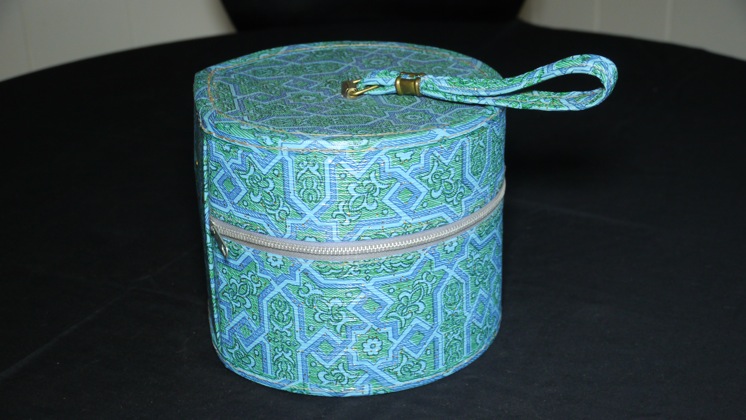
Li Ling-Ai’s Mod Turquoise Hat Box could be a fashion accessory in itself
The contents of the box did not disappoint. I discovered three exquisitely crafted little numbers. A pink brocade small saucer hat with a stunning plume was my favorite.

Plumed pink brocade hat by Nick Savage
I had a lot of fun imagining the type of occasion Ling-Ai chose to wear this hat to.


While photographing this hat, I noticed the amazing craftsmanship that went into it’s construction.

Detail of pink brocade hat.
A signed label was sewn into the inside lining of the hat. Nick Savage appears to be the talented milliner who made it.
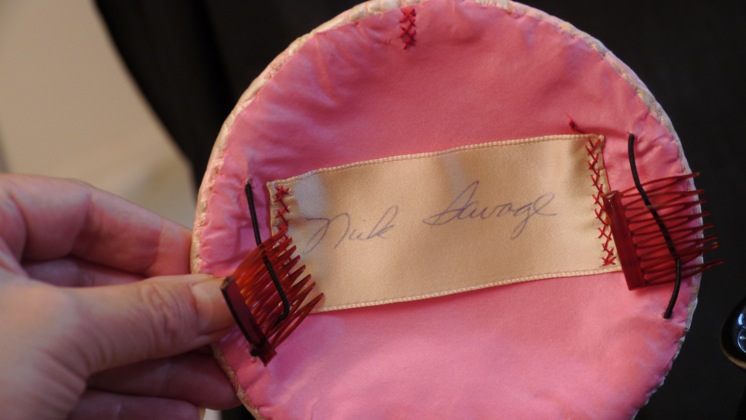
These next two pieces were also made by Nick. And are equally exquisite.

Gold ponytail hat by Nick Savage.Gold-banded camellia hat by Nick Savage

Gold-banded camellia hat by Nick Savage
The little details are marvelous. Check out the separate braided strands that start this gold pony-tail plume.

And the perfect positioning of the brocaded fabric.

The camellia on this inventive piece was a little a squished, but I imagine it was pretty sumptious when Ling-Ai wore it back in the day.

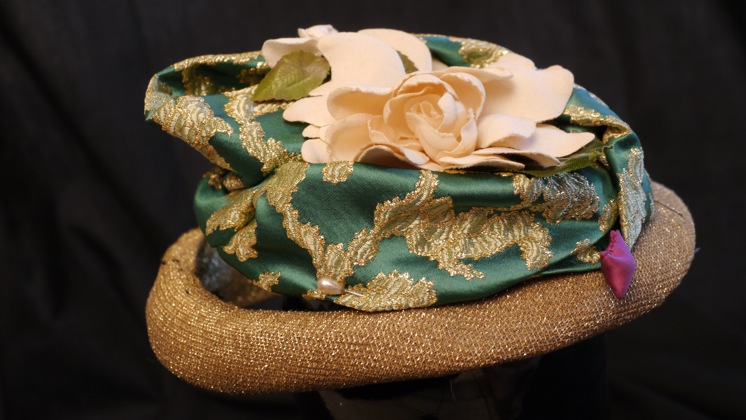

I couldn’t find any information on the internet about the talented Nick Savage. But I did find a little label in the inside of this camellia hat.
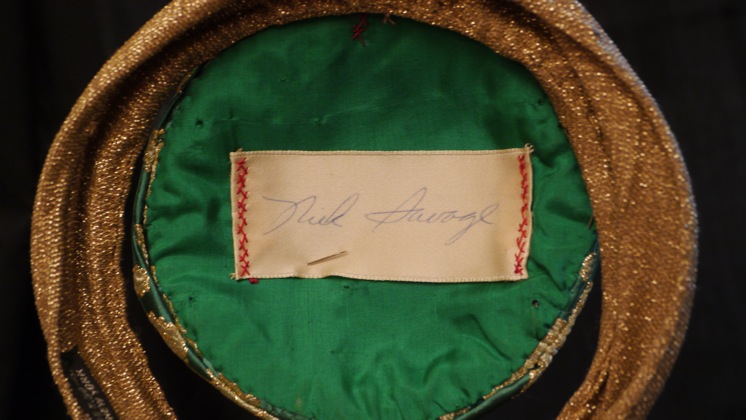
It had a New York City address — 350 East 50th Street — from Google Maps it looks to be a building just off Lexington Ave. If any fashionistas have any more information on him, please let me know. I have Mr. Savage’s millinery gifts, Li Ling-Ai’s fashion sense and her niece’s foresight to thank for a wonderful afternoon spent in a world of gamorous fantasy.

Black velvet rhinestone and pearl studded hat from Li Ling-Ai’s collection.
To top off my post I’ll leave with a few shots of another gorgeous topper in Ling-Ai’s collection (by an unknown maker).


February 19, 2012 — What do HUGO and FINDING KUKAN have in common?

Martin Scorce’s HUGO is a tribute to film pioneer Georges Melies
Like many people who were charmed by Scorcese’s recent film HUGO, I had little knowledge of early film history or Georges Melies before seeing the movie, so I headed to the internet afterwards to find out a little more about him.

Ben Kingsley (center right, as Georges Melies) confers with director/producer Martin Scorsese (far right) on the set of HUGO, from Paramount Pictures and GK Films. Photo: Jaap Buitendijk.
Although Melies is recognized today as an early film innovator with a fabulous imagination, he fell out of favor during his lifetime and many of his films were melted down or destroyed.

Still from Melies’s THE MAN WITH THE RUBBER HEAD
While reading about Melies, I ran across Wikipedia’s list of Rediscovered Films. Happily a couple of Melies’s films from the 1890s have been rediscovered in this century.
Scrolling down the list, look what film shows up in the 1940’s … Rey Scott’s KUKAN!
And that’s the answer to a film trivia question that might someday be asked on a game show in the far future – HUGO and FINDING KUKAN are both about rediscovering lost films and forgotten filmmakers.

In 1961 the French government issued a postage stamp in honor of Georges Melies’s cinematic contributions.
Maybe someday KUKAN, Rey Scott, and Li Ling-Ai will have a postage stamp dedicated to them too.








